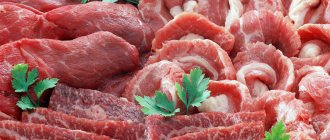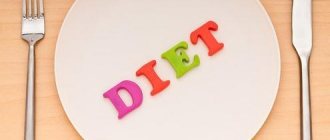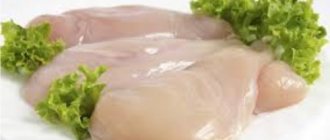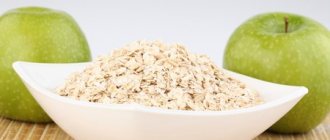Basic rules for eating diet table No. 1a
So, like every medical diet, dietary table No. 1a has a list of foods that are prohibited for consumption and that should be added to the diet. What's on this list?
Recommended Products:
- Soups. The best option would be slimy soups prepared with the addition of semolina, barley, rice or oatmeal. You can add egg or milk mixture, as well as butter.
- Meat and poultry. Suitable for beef, rabbit, veal. Chicken breast and turkey are also allowed. The meat must be boiled several times and then passed through a meat grinder to create a meat soufflé.
- Fish. Boil cod, hake and similar varieties without skin.
- Freshly prepared cottage cheese, cream and milk.
- Scrambled eggs.
- Liquid porridges based on cereal flour, semolina, oatmeal, rice and pureed buckwheat are allowed. Adding cream/milk is allowed.
- Beverages. You are allowed to drink weak tea, rosehip decoction, juices diluted in half with water.
- Jelly, jelly.
- Oil. Vegetable and creamy.
Prohibited products:
- Sauces and spices. Absolutely all sauces (mayonnaise, cheese sauces, ketchup, etc.) should be excluded from the menu.
- Vegetables. Also completely excluded.
- All snacks in the form of salads, jellies, smoked meats and sausages should also be removed from your daily menu.
- Confectionery.
- Floury.
- Pure berries.
- Beverages. You should forget about coffee, soda, cocoa, and alcohol.
- Cheese, sour cream, fatty cottage cheese and fermented milk products are prohibited
Hospital diet
Diets are now divided into therapeutic and for losing weight. The hospital diet is one of the first. It is designed to normalize nutrition, make it balanced and beneficial for the body. Here, losing weight is seen more as an addition rather than a goal, but does not exclude its use by those losing weight. This approach is often considered as a hospital diet, and is often identified with common diets used in hospitals, aimed at speedy recovery of the patient. The diet is quite varied and includes eating small portions for two weeks, which helps restore strength and metabolic processes in the body. At the same time, you can lose 4-5 kilograms per cycle. Below is a sample hospital diet menu for a week. The first day
- Breakfast: rice porridge with water, a couple of rye toasts, an apple
- Lunch: soup with vegetables and lean meat, cutlet
- Afternoon snack: salad of eggs, cucumbers, cabbage, herbs (250 gr.)
- Dinner: buckwheat with chicken (210 gr.), kefir
Second day
- Breakfast: a couple of baked bananas, 150 gr. cottage cheese
- Lunch: pureed mushroom and pea soup, 100 gr. boiled chicken
- Afternoon snack: pudding (100 gr.), orange
- Dinner: steamed fish, a couple of potatoes (240 gr.)
Day three
- Breakfast: a piece of cheese, an omelette of two eggs
- Lunch: okroshka, a couple of crackers
- Afternoon snack: vinaigrette (180 gr.)
- Dinner: stewed meat with vegetables (240 gr.)
Day four
- Breakfast: salad of celery, peas, sausage, greens (300 gr.)
- Lunch: borscht with beef, a little sour cream
- Afternoon snack: fruit salad (270 gr.)
- Dinner: rice with fish balls
Day five
- Breakfast: dried fruit compote, oatmeal
- Lunch: salad of cod, potatoes, mushrooms, corn (270 gr.)
- Afternoon snack: stewed zucchini with onions, eggplants (230 gr.)
- Dinner: beef chop with lentils (320 gr.)
Day six
- Breakfast: orange juice, rye croutons, several plums
- Lunch: chicken meat, boiled corn (320 gr.)
- Afternoon snack: cottage cheese casserole, banana
- Dinner: macaroni with cheese and garlic (230 gr.)
Day seven
- Breakfast: grated carrots, two boiled eggs
- Lunch: cod soup, potatoes, sorrel
- Afternoon snack: blueberry jelly, a couple of apricots
- Dinner: shrimp (270 gr.), 120 ml. milk
The hospital diet menu proposed here is well suited for both an ordinary person who wants to adjust their diet, and as a diet option for stomach illness. As a basis, you take small portions for consumption four times a day. It is better to eat at intervals of three hours. The first meal is recommended around 9 a.m., the last - at 6 p.m. Snacking between meals is strictly prohibited. Two weeks of such a diet give excellent results, and help normalize digestion and lose a couple or three kilograms without particularly straining, which will be useful for those who are just starting to get involved and do not have a goal to lose weight radically.
In contact with
LiveJournal
Recommendations from nutritionists
Very often people who do not suffer from gastritis or stomach ulcers go on this diet. In this case, you should remember some of the rules that diet No. 1a has.
So, what do experts advise those who go on this diet?
This dietary table helps perfectly in cases where the condition of the stomach and duodenum is critical. The diet involves partial or complete abstinence from table salt, which helps avoid salt retention in the body. This diet can be called low-calorie, since the amount of carbohydrates is reduced to a minimum.
Cold and hot foods should be completely avoided! All food should be served warm so as not to injure the gastrointestinal tract.
Food should be boiled and steamed, and then ground, so as not to mechanically injure the stomach. Absolutely all food should be in liquid or porridge form.
This diet helps you lose weight if you strictly adhere to the weekly menu. You should leave the diet gradually, since the diet for diet No. 1a implies six meals a day, and the transition to regular three meals a day can lead to rapid weight gain.
About the medical diet “1 table”
The gentle therapeutic diet “table number 1” is traditionally prescribed to patients diagnosed with peptic ulcer of the stomach and duodenum in the subsiding/fading stage (indicated from six months to a year after the attack).
In some clinical situations, the treating gastroenterologist and/or nutritionist prescribes adherence to this diet during an exacerbation of chronic gastritis with increased secretion of gastric juice. It is advisable to use table No. 1 for infectious diseases of the gastrointestinal tract (if there is no diarrhea), as well as for a hernia of the diaphragmatic food opening.
Following the therapeutic diet provided for by the medical diet “Table No. 1” brings significant relief from gastric pathologies, both during exacerbations and during periods of remission/recovery, since it is aimed at reducing the irritating effect on the damaged walls of the duodenum and stomach.
The diet is divided into table No. 1a and table No. 1b, depending on the ongoing processes. The classic diet for stomach ulcers, table 1, is similar to the diet for gastritis and is prescribed after sequentially completing diets No. 1a and No. 1b.
Basic Rules
The menu provides for a reduction in mechanical, chemical and thermal stress on the gastrointestinal tract. This diet helps to activate the processes of regeneration and healing of existing ulcers and erosions, reduce acute inflammatory processes and normalize the secretory-motor function of the stomach.
Basic principles of the “Table No. 1” diet:
- the length of time to follow the medical diet is prescribed by the doctor (6-12 months);
- portion size – moderate;
- meals are fractional (five-six-seven meals a day);
- the temperature of the food served is neutral (both ice-cold and hot food are unacceptable);
- products that activate the secretion of bile. juice, limited in diet;
- daily menu calories from 2300 to 2800 kcal;
- water and drinking regime – 1.6 l/day;
- culinary and thermal processing of products - boiling, steaming, rubbing before consumption, some of the dishes specified below are acceptable in baked form.
General rules
Obesity is a pathology characterized by increased deposition of fat in the body, leading to excess weight. There are many types of obesity, but now we are talking about nutritional obesity, in which obesity is the leading symptom of the disease, and not a consequence or symptom of nervous or primary endocrine diseases (diabetes, hypothyroidism, Cushing's syndrome).
Nutritional obesity develops when calorie intake exceeds the body's energy expenditure and is characterized by a gradual increase in body weight with a relatively uniform distribution of subcutaneous adipose tissue.
There are 4 degrees of obesity:
- at stage I, the actual body weight exceeds the norm by 15-29%;
- at stage II by 30-49%;
- at stage III – by 50-100%;
- at stage IV – more than 100%.
Everyone can determine approximately their normal weight using Brock's formula (height in centimeters minus 100). The fundamental method of treating obesity is diet, combined with physical activity.
The main diet for obesity is a diet with reduced energy value - therapeutic Diet No. 8 (Table No. 8 according to Pevzner) and its variants 8A and 8o. The level of modification of the energy intensity of the diet is determined by the degree of obesity and the individual energy needs of the patient’s body, taking into account the level of physical activity, age, gender, and labor intensity.
The energy value of the main diet varies between 1700-1800 Kcal (90-110 g proteins of which 60% are animal, 80-85 g fats - of which 30% are vegetable and 150 - 170 g carbohydrates); sodium chloride consumption is limited to 5-6 g/day; free liquid - at the level of 1-1.5 liters.
The protein content in the diet should be within normal limits and provide 15–20% of the total calorie intake with a slight predominance of animal proteins. Various types of legumes (peas, lentils, beans) and soy products are mainly used as a source of vegetable protein.
Animal proteins are provided by including lean meats (up to 150 g/day) in the diet - veal, beef, chicken, rabbit, turkey, limiting pork and excluding fatty meat (duck, goose), as well as meat products (ham, sausage, canned food) ).
When compiling a diet, it is important to completely exclude quickly absorbed carbohydrates (sugar, honey, jams, candies, preserves), which can be replaced with sweeteners (saccharin, aspartame). The use of sweeteners (fructose, xylitol, sorbitol) that have a sufficiently high energy value is impractical.
It is recommended to distribute carbohydrates evenly between all meals. It is recommended to use foods with a low glycemic index in the diet. Bread is limited to 100 g per day or excluded altogether.
In order to create a feeling of fullness in the diet, the consumption of foods containing a lot of dietary fiber (up to 30-40 g/day) is increased - dietary varieties of bread, raw vegetables, fruits, grains, bran (barley, oat and wheat). These products are low in calories and have a large volume.
Fresh cucumbers
Radishes, fresh cucumbers, all types of cabbage, zucchini, pumpkin, turnips, and tomatoes are widely included in the diet, and it is recommended to consume them partially raw. Dishes made from green peas, potatoes, carrots, beets, rutabaga (up to 200 g/day), as well as pickled and salted vegetables are limited.
It is extremely important to control in the diet not only the quantity, but also the quality composition of fat. When limiting fat to 30% of the total daily calorie intake through the use of predominantly low-fat/low-fat foods, it is important to maintain an equal ratio between mono/saturated and polyunsaturated fatty acids.
Avoid sweet cheeses, cream, fatty cottage cheese, fermented baked milk, fatty cheeses, and baked milk. It is important to avoid including hidden fats in your diet, such as those found in smoked meats, offal, sausages, cheeses, ice cream, nuts, confectionery, and cookies. It is important to have omega-3 PUFAs in the diet, which are rich in flax and soybean oil, halibut, and capelin.
It is important to provide the diet with sufficient content and ratio of minerals, microelements, and vitamins. It is extremely useful to include foods rich in potassium salts (seafood, soybeans, potatoes, beans, dried fruits.
cabbage, black currants, apricots) and magnesium (buckwheat, carrots, rose hips, bran), iodine (seafood, seaweed), antioxidant vitamins (E, A, C) - vegetable oils, rose hip decoction, fruits, berries and vegetables .
Salt intake is limited to 5 g/day. At the same time, in the presence of severe persistent hypertension, salt may not be added to food.
All foods that stimulate the appetite (savory snacks, seasonings, strong broths and sauces), as well as alcoholic drinks, are excluded from the diet.
Drinking regimen - 1.5 liters on average per day in the form of mineral and drinking water, herbal teas, unsweetened fruit, vegetable and berry juices. It is recommended to drink water when you feel hungry, which helps suppress it for a while.
Against the background of the diet, it is recommended to carry out fasting days (fruit and vegetable, cottage cheese and kefir) 1-3 times a week. Culinary processing of products involves cooking food mainly boiled, steamed and stewed using appropriate technologies.
Varieties
At higher (3-4) degrees of obesity, varieties of Diet 8 with reduced energy consumption of the diet are prescribed.
We invite you to read: Mezim forte: analogues and substitutes, what does the drug help with? — Diabetes
Diet No. 8A - energy value is reduced to 1200-1300 Kcal (proteins -80 g, of which up to 70% are of animal origin; fats -60 g, of which 30-35% are vegetable fats and carbohydrates - 130 g).
If Diets No. 8 and 8A are insufficiently effective (for obesity of III-IV degree), Diet No. 8o is prescribed. Energy value is 600-800 Kcal (40-50 g - proteins; 30-40 g - fats and 50-70 g - carbohydrates).
At the same time, fasting days per week are practiced: apple (up to 1.5 kg of apples/day), cottage cheese (500 grams of low-fat cottage cheese with 2-3 glasses of green tea), watermelon (up to 1.5-2 kg of watermelon pulp), kefir (1.5 liters of kefir/day) and others).
When using Diets 8A and 8o, you should not start fasting immediately with very low-calorie diets. Start with a moderately reduced Diet No. 8 and then gradually switch to low-energy diets.
When prescribing low-calorie diets, it is necessary to monitor not only weight, but also the general condition of the body. If side effects appear, such as high fatigue, weakness, nausea, cold intolerance, the characteristic smell of acetone, diarrhea/constipation, dry skin, dysmenorrhea/amenorrhea, heart rhythm disturbances, it is necessary to start quitting such a diet.
Authorized Products
Bran and black bread are allowed in the diet (up to 100 g/day). Soups are prepared mainly with vegetable broth, and 1-2 times a week soups with weak, low-fat meat or fish broth with the addition of vegetables or potatoes, without salt, are allowed. The meat for the soup is pre-cooked for 10-15 minutes and the resulting broth is drained, after which the “secondary” broth is boiled.
For second courses, lean boiled meat (no more than 100 g/day) of poultry, turkey, rabbit or lean beef is used. From fish, the diet can include up to 150 g of low-fat varieties (pike perch, pike, cod, carp), as well as seafood - shrimp, mussels, squid. Vegetables (cucumbers, tomatoes, various types of cabbage, zucchini and lettuce) are used as a side dish (up to 200 g/day).
Dairy products include yogurt, low-fat milk, kefir, and low-fat cottage cheese in the diet. As snacks, vinaigrettes and salads seasoned with vegetable oil are introduced into the diet.
Drinks in the diet include black and green tea, weak natural coffee, mineral water, sour fruit and berry juices.
Drinks - tea, tea with milk, tomato juice, juices from sour varieties of berries and fruits, alkaline. Total liquid (together with soup, milk, curdled milk, compote, drinks) up to 5-6 glasses per day.
| Proteins, g | Fats, g | Carbohydrates, g | Calories, kcal | |
Vegetables and greens | ||||
| greenery | 2,6 | 0,4 | 5,2 | 36 |
| squash caviar | 1,2 | 7,0 | 7,4 | 97 |
| zucchini | 0,6 | 0,3 | 4,6 | 24 |
| broccoli | 3,0 | 0,4 | 5,2 | 28 |
| cauliflower | 2,5 | 0,3 | 5,4 | 30 |
| cucumbers | 0,8 | 0,1 | 2,8 | 15 |
| soybeans | 34,9 | 17,3 | 17,3 | 381 |
| tomatoes | 0,6 | 0,2 | 4,2 | 20 |
Fruits | ||||
| baked sweet and sour apples | 0,5 | 0,5 | 12,3 | 59 |
Cereals and porridges | ||||
| buckwheat | 4,5 | 2,3 | 25,0 | 132 |
| oatmeal with water | 3,0 | 1,7 | 15,0 | 88 |
| wheat bran | 15,1 | 3,8 | 53,6 | 296 |
| rye bran | 11,2 | 3,2 | 32,0 | 221 |
Bakery products | ||||
| whole grain bread | 10,1 | 2,3 | 57,1 | 295 |
Dairy | ||||
| skim milk | 2,0 | 0,1 | 4,8 | 31 |
| kefir product bio balance 0% | 3,2 | 0,1 | 4,5 | 32 |
Cheeses and cottage cheese | ||||
| cottage cheese 0% (low fat) | 16,5 | 0,0 | 1,3 | 71 |
Meat products | ||||
| lean beef | 22,2 | 7,1 | 0,0 | 158 |
| rabbit | 21,0 | 8,0 | 0,0 | 156 |
Bird | ||||
| boiled chicken breast | 29,8 | 1,8 | 0,5 | 137 |
| boiled chicken drumstick | 27,0 | 5,6 | 0,0 | 158 |
| boiled chicken fillet | 30,4 | 3,5 | 0,0 | 153 |
| boiled turkey fillet | 25,0 | 1,0 | – | 130 |
Eggs | ||||
| hard-boiled chicken eggs | 12,9 | 11,6 | 0,8 | 160 |
Fish and seafood | ||||
| boiled fish | 17,3 | 5,0 | 0,0 | 116 |
| squid | 21,2 | 2,8 | 2,0 | 122 |
| shrimps | 22,0 | 1,0 | 0,0 | 97 |
| mussels | 9,1 | 1,5 | 0,0 | 50 |
| zander | 19,2 | 0,7 | – | 84 |
| cod | 17,7 | 0,7 | – | 78 |
| pike | 18,4 | 0,8 | – | 82 |
Oils and fats | ||||
| vegetable oil | 0,0 | 99,0 | 0,0 | 899 |
| linseed oil | 0,0 | 99,8 | 0,0 | 898 |
Non-alcoholic drinks | ||||
| mineral water | 0,0 | 0,0 | 0,0 | – |
| green tea | 0,0 | 0,0 | 0,0 | – |
| black tea | 20,0 | 5,1 | 6,9 | 152 |
Juices and compotes | ||||
| tomato juice | 1,1 | 0,2 | 3,8 | 21 |
| rose hip juice | 0,1 | 0,0 | 17,6 | 70 |
| * data is per 100 g of product | ||||
Products such as wheat bread and bakery products, all types of fatty meat (pork, goose, duck) and meat products from them (ham, sausages, sausages, canned food), as well as fatty fish, pork, beef and confectionery fat are completely excluded from the diet. .
Any strong broths based on meat, fish and mushrooms, fried, salted and smoked foods, fried eggs, fatty cottage cheese, cream, sweet yogurt, sweet cheeses, baked milk, fermented baked milk, salty and fatty cheeses are excluded. It is not allowed to include rice, legumes, oatmeal and semolina, pasta, spicy and fatty snacks, spices and mayonnaise in the diet.
Bananas, dates, grapes, figs, raisins and sweet varieties of other fruits are prohibited. It is not allowed to include confectionery, chocolate, sweets, sugar, honey, jam, preserves, ice cream, jelly and any alcohol-containing drinks in the diet.
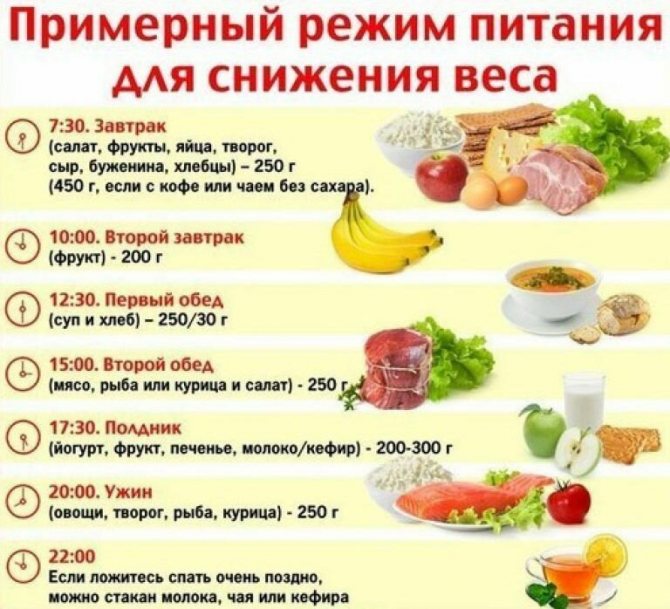
Foods that stimulate appetite are excluded: horseradish, pepper, mustard, various seasonings and hot fatty sauces. The consumption of salt, butter, green peas, potatoes, carrots, beets, rutabaga (up to 200 g per day), as well as pickled and salted vegetables and mushrooms is limited. As for drinks, all juices from sweet fruits, cocoa, and tea with milk are prohibited.
| Proteins, g | Fats, g | Carbohydrates, g | Calories, kcal | |
Vegetables and greens | ||||
| beans | 6,0 | 0,1 | 8,5 | 57 |
| peas | 6,0 | 0,0 | 9,0 | 60 |
| green peas | 5,0 | 0,2 | 13,8 | 73 |
| fried potato | 2,8 | 9,5 | 23,4 | 192 |
| carrot | 1,3 | 0,1 | 6,9 | 32 |
| beet | 1,5 | 0,1 | 8,8 | 40 |
| beans | 7,8 | 0,5 | 21,5 | 123 |
| horseradish | 3,2 | 0,4 | 10,5 | 56 |
Fruits | ||||
| melon | 0,6 | 0,3 | 7,4 | 33 |
Mushrooms | ||||
| mushrooms | 3,5 | 2,0 | 2,5 | 30 |
Nuts and dried fruits | ||||
| nuts | 15,0 | 40,0 | 20,0 | 500 |
| dried fruits | 2,3 | 0,6 | 68,2 | 286 |
| sunflower seeds | 20,7 | 52,9 | 3,4 | 578 |
Snacks | ||||
| potato chips | 5,5 | 30,0 | 53,0 | 520 |
Cereals and porridges | ||||
| white rice | 6,7 | 0,7 | 78,9 | 344 |
Flour and pasta | ||||
| pasta | 10,4 | 1,1 | 69,7 | 337 |
| noodles | 12,0 | 3,7 | 60,1 | 322 |
| pancakes | 6,1 | 12,3 | 26,0 | 233 |
| vareniki | 7,6 | 2,3 | 18,7 | 155 |
| pancakes | 6,3 | 7,3 | 51,4 | 294 |
| dumplings | 11,9 | 12,4 | 29,0 | 275 |
Bakery products | ||||
| bagels | 16,0 | 1,0 | 70,0 | 336 |
| white bread crackers | 11,2 | 1,4 | 72,2 | 331 |
| wheat bread | 8,1 | 1,0 | 48,8 | 242 |
Confectionery | ||||
| jam | 0,3 | 0,2 | 63,0 | 263 |
| candies | 4,3 | 19,8 | 67,5 | 453 |
Cakes | ||||
| cake | 4,4 | 23,4 | 45,2 | 407 |
Chocolate | ||||
| chocolate | 5,4 | 35,3 | 56,5 | 544 |
Raw materials and seasonings | ||||
| mustard | 5,7 | 6,4 | 22,0 | 162 |
| ginger | 1,8 | 0,8 | 15,8 | 80 |
| mayonnaise | 2,4 | 67,0 | 3,9 | 627 |
| honey | 0,8 | 0,0 | 81,5 | 329 |
| sugar | 0,0 | 0,0 | 99,7 | 398 |
| vinegar | 0,0 | 0,0 | 5,0 | 20 |
Dairy | ||||
| milk 3.2% | 2,9 | 3,2 | 4,7 | 59 |
| condensed milk | 7,2 | 8,5 | 56,0 | 320 |
| kefir 3.2% | 2,8 | 3,2 | 4,1 | 56 |
| cream 20% (medium fat content) | 2,8 | 20,0 | 3,7 | 205 |
| cream 35% (fat) | 2,5 | 35,0 | 3,0 | 337 |
| sour cream 25% (classic) | 2,6 | 25,0 | 2,5 | 248 |
| Ryazhenka | 2,8 | 4,0 | 4,2 | 67 |
Cheeses and cottage cheese | ||||
| cheese | 24,1 | 29,5 | 0,3 | 363 |
| cottage cheese 18% (fat) | 14,0 | 18,0 | 2,8 | 232 |
Meat products | ||||
| fatty pork | 11,4 | 49,3 | 0,0 | 489 |
| salo | 2,4 | 89,0 | 0,0 | 797 |
| bacon | 23,0 | 45,0 | 0,0 | 500 |
| ham | 22,6 | 20,9 | 0,0 | 279 |
| pork stew | 13,0 | 35,0 | 0,0 | 367 |
Sausages | ||||
| smoked sausage | 28,2 | 27,5 | 0,0 | 360 |
Bird | ||||
| fried chicken | 26,0 | 12,0 | 0,0 | 210 |
| duck | 16,5 | 61,2 | 0,0 | 346 |
| goose | 16,1 | 33,3 | 0,0 | 364 |
Eggs | ||||
| fried egg | 11,9 | 15,3 | 0,7 | 192 |
Fish and seafood | ||||
| pink salmon | 20,5 | 6,5 | 0,0 | 142 |
| Red caviar | 32,0 | 15,0 | 0,0 | 263 |
| cod roe | 24,0 | 0,2 | 0,0 | 115 |
| salmon | 19,8 | 6,3 | 0,0 | 142 |
| herring | 16,3 | 10,7 | – | 161 |
| cod (liver in oil) | 4,2 | 65,7 | 1,2 | 613 |
| trout | 19,2 | 2,1 | – | 97 |
Oils and fats | ||||
| peasant unsalted butter | 1,0 | 72,5 | 1,4 | 662 |
| vegetable-fat spread | 0,0 | 40,0 | 0,0 | 360 |
| cod liver oil | 0,0 | 99,8 | 0,0 | 898 |
| solid confectionery fat | 0,0 | 99,8 | 0,0 | 898 |
| rendered pork fat | 0,0 | 99,6 | 0,0 | 896 |
Alcoholic drinks | ||||
| white dessert wine 16% | 0,5 | 0,0 | 16,0 | 153 |
| vodka | 0,0 | 0,0 | 0,1 | 235 |
| cognac | 0,0 | 0,0 | 0,1 | 239 |
| liquor | 0,3 | 1,1 | 17,2 | 242 |
| beer | 0,3 | 0,0 | 4,6 | 42 |
